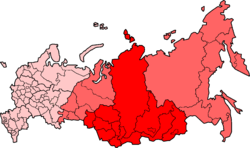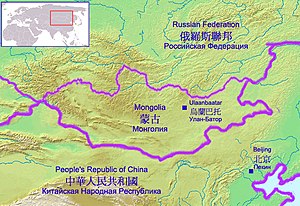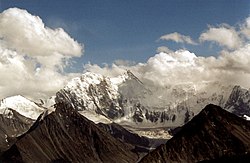Siberia
- This article refers to Siberia as a whole; for specific information about the federal district, see Siberian Federal District. For other uses, see Siberia (disambiguation).


Siberia (Template:Lang-ru, Sibir; Template:Lang-tt) is a vast region of Russia constituting almost all of Northern Asia. It extends eastward from the Ural Mountains to the Pacific Ocean, and southward from the Arctic Ocean to the hills of north-central Kazakhstan and the borders of both Mongolia and China. All but the extreme south-western area of Siberia lies in Russia, and it makes up about 56% of that country's territory.
The origin of name
Some sources say that it originates from the Turkic for "sleeping land."[citation needed] Another version is that this name was the tribal name of Sibirs, Eurasian nomads, later assimilated to Siberian Tatars.[citation needed] Dr. Pamela Kyle Crossley, professor of history at Dartmouth College, asserts that the Russians named Siberia after the Sibe/Xibe.[citation needed] The modern meaning of the name appeared in Russian language after the conquest of Siberia Khanate.[citation needed]
Administrative divisions

Geographically, Siberia includes the federal subjects of the Urals Federal District, Siberian Federal District and Sakha (Yakutia) Republic, which is a part of the Far Eastern Federal District (see a list of subjects below). From the historical point of view, the whole Russian Far East is considered a segment of Siberia.
- Altai Krai, administrative center—Barnaul
- Altai Republic, capital—Gorno-Altaysk
- Buryat Republic, capital—Ulan-Ude
- Chita Oblast, administrative center—Chita
- Irkutsk Oblast, administrative center—Irkutsk
- Republic of Khakassia, capital—Abakan
- Kemerovo Oblast, administrative center—Kemerovo
- Koryak Autonomous Okrug, administrative center—Palana
- Krasnoyarsk Krai, administrative center—Krasnoyarsk
- Novosibirsk Oblast, administrative center—Novosibirsk
- Omsk Oblast, administrative center—Omsk
- Sakha (Yakutia) Republic, capital—Yakutsk
- Tomsk Oblast, administrative center—Tomsk
- Tuva Republic, capital—Kyzyl

Major cities include:
See also a map of the thirty largest Siberian cities with links to Wikipedia.
History
Siberia was occupied by differing groups of nomads such as the Yenets, the Nenets, the Huns, and the Uyghurs. The Khan of Sibir in the vicinity of modern Tobolsk was known as a prominent figure who endorsed Kubrat as Khagan in Avaria in 630. The area was conquered by the Mongols in the 13th century and eventually became the autonomous Siberian Khanate.
The growing power of Russia to the west began to undermine the Khanate in the 16th century. First, groups of traders and Cossacks began to enter the area, and then the Russian army began to set up forts further and further east. Towns like Mangazeya, Tara, Yeniseysk, and Tobolsk sprang up, the latter being declared the capital of Siberia. By the mid-17th century, the Russian-controlled areas had been extended to the Pacific.
Siberia remained a mostly unexplored and uninhabited area. During the following few centuries, only a few exploratory missions and traders inhabited Siberia. The other group that was sent to Siberia consisted of prisoners exiled from western Russia or Russian-held territories like Poland (see katorga).
The first great change to Siberia was the Trans-Siberian railway, constructed in 1891–1903. It linked Siberia more closely to the rapidly-industrializing Russia of Nicholas II. Siberia is filled with natural resources and during the 20th century these were developed, and industrial towns cropped up throughout the region.
Katorga and Gulag
Russia, later the Soviet Union, operated a series of labor camps, known as the Gulag. This became so frequent that "Siberia" came to be used as metaphor for exile and punishment: "a bureaucratic Siberia" ([1],[2])
In analogue fashion, one working-class district of downtown Stockholm, Sweden, in the late 19th century began being called Sibirien (Siberia) referring to its low-cost tenement houses being built in what was then an outskirts area. The name stuck, and has become part of Stockholm urban lore, though the district is in fact thoroughly inner-city and has been gentrified in the last twenty years (it is now expensive to own an apartment there). ([3])
Geography and geology

|

|

|

|

|

|

With an area of 10,007,400 km2, Siberia makes up roughly 58% of the total area of Russia. Major geographical zones include the West Siberian Plain and the Central Siberian Plateau.
The West Siberian Plain consists mostly of Cenozoic alluvial deposits and is extraordinarily low-lying, so much so that a rise of fifty metres in sea level would cause all land between the Arctic Ocean and Novosibirsk to be inundated. Many of the deposits on this plain result from ice dams; having reversed the flow of the Ob and Yenisei Rivers, so redirecting them into the Caspian Sea (perhaps the Aral as well). It is very swampy and soils are mostly peaty Histosols and, in the treeless northern part, Histels. In the south of the plain, where permafrost is largely absent, rich grasslands that are an extension of the Kazakh Steppe formed the original vegetation (almost all cleared now).
The Central Siberian Plateau is an extremely ancient craton (sometimes called Angaraland) that formed an independent continent before the Permian (see Siberia (continent)). It is exceptionally rich in minerals, containing large deposits of gold, diamonds, and ores of manganese, lead, zinc, nickel, cobalt and molybdenum. Much of the area includes the Siberian Traps which is a large igneous province. The massive eruptive period was approximately co-incident with the Permian-Triassic extinction event. The volcanic event is said to be the largest known volcanic eruption in Earth history. Only the extreme northwest was glaciated during the Quaternary, but almost all is under exceptionally deep permafrost and the only tree that can thrive, despite the warm summers, is the deciduous Siberian Larch (Larix sibirica) with its very shallow roots. Outside the extreme northwest, the taiga is dominant. Soils here are mainly Turbels, giving way to Spodosols where the active layer becomes thicker and the ice content lower.
Eastern and central Sakha comprise numerous north-south mountain ranges of various ages. These mountains extend up to almost three thousand metres in elevation, but above a few hundred metres they are devoid of vegetation to an extraordinary degree. The Verkhoyansk Range was extensively glaciated in the Pleistocene, but the climate was too dry for glaciation to extend to low elevations. At these low elevations are numerous valleys, many of them deep, and covered with larch forest except in the extreme north, where tundra dominates. Soils are mainly Turbels and the active layer tends to be less than a meter deep except near rivers.
Lakes and rivers
- Anabar River
- Angara River
- Indigirka River
- Irtysh River
- Kolyma River
- Lake Baikal
- Lena River
- Ob River
- Tunguska River
- Uvs Nuur Lake
- Yana River
- Yenisei River
Mountain ranges

- Altai Mountains
- Anadyr Range
- Baikal Mountains
- Chamar-Daban
- Chersky Range
- Dzhugdzhur Mountains
- Gydan Mountains
- Koryak Mountains
- Sayan Mountains
- Tannu-Ola Mountains
- Ural Mountains
- Verkhoyansk Mountains
- Yablonoi Mountains
A harsh climate has limited Siberia's development and population growth. The region has an abundance of natural resources, including many minerals, vast oil fields, rich forests, and grasslands in the extreme southwest that are good for farming. However, the winters are long and bitter. Ice and snow cover most of the region for about six months of the year. The temperature can drop below -68°C (-90°F). Most of the coastal waters, lakes, and rivers freeze for much of the year.
Demographics
Siberia has population density of only three people per square kilometer. Most Siberians are Russians. Ethnic Russians are descended from Slavs who lived in Eastern Europe several hundred years ago. Such Mongol and Turkic groups as Buryats, Tuvinians, and Yakuts lived in Siberia originally, and descendants of these peoples still live there. Other ethnic groups include Kets, Evenks, Chukchis, Koryaks, and Yukaghirs. See the Northern indigenous peoples of Russia article for more.
About 70% of Siberia's people live in cities. Most city people live in apartments. Many people in rural areas live in simple, but more spacious, log houses. Novosibirsk is the largest city in Siberia, with a population of about 1.5 million. Tobolsk, Tomsk, Irkutsk and Omsk are the older, historical centers.
Religion
Like throughout all of Russia, religion has an important role in Siberian life. There is a variety of beliefs throughout Siberia including Buddhism, Islam, Judaism, and Christianity.[4] The predominant group is the Orthodox Church. While many Jews have repatriated to Israel, many Jews intermarry in tradition. However, native religion dates back hundreds of years. The vast terrority of Siberia has many different local traditions of gods. These include: Ak Ana, Anapel, Bugady Musun, Kara Khan, Khaltesh-Anki, Kini'je, Ku'urkil, Nga, Nu'tenut, Numi-Torem, Numi-Turum, Pon, Pugu, Todote, Toko'yoto, Tomam, Xaya Iccita, Zonget.
Places with sacred areas include Olkhon, an island in Lake Baikal.
See also Shamanistic cultures in Siberia.
Trans-Siberian Railway
The best way to tour Siberia is through the Trans-Siberian Railway. The train has 2nd class 4-berth compartments, 1st class 2-berth compartments, and a restaurant car.
Climate
The climate of Siberia varies dramatically. On the north coast, north of the Arctic Circle, there is just a very short (about one-month-long) summer.
Almost all the population lives in the south, along the Trans-Siberian railroad. The climate here is continental subarctic, with the annual average temperature about 0°C and roughly −15°C average in January and +20°C in July.[1] With a growing season being of about 150-180 days in a year,[citation needed][dubious – discuss] Southern Siberia is good enough for profitable agriculture, as was proven in the early twentieth century.
The southwesterly winds of Southern Siberia bring warm air from Central Asia and the Middle East. The climate in West Siberia (Omsk, Novosibirsk) is several degrees warmer than in the East (Irkutsk, Chita).
With a lowest record temperature of -71.2°C, Oymyakon (Sakha Republic) has the distinction of being the coldest town on Earth. In general, Sakha is the coldest Siberian region.
Nevertheless, as far as Imperial Russia plans of settlement are concerned, the cold was never viewed as an issue. In the winter, Southern Siberia sits near the center of the semi-permanent Siberian High, so winds are usually light in the winter.
Famous Siberians
- Vasily Surikov (born in Krasnoyarsk), painter
- Mikhail Vrubel (Omsk), painter
- Aleksandr Pokryshkin (Novosibirsk), WWII fighter pilot
- Viktor Astafiyev (Krasnoyarsk Krai), writer
- Vasily Shukshin (Altai Krai), writer, cinema actor and director
- Nikolay Kamov (Irkutsk), leading constructor of the Kamov helicopter design bureau
- Mikhail Mil (Irkutsk), founder of the Mil Moscow Helicopter Plant
- Alexander Karelin (Novosibirsk), Greco-Roman wrestler, 3-times olympic champion.
- Dimitri Mendeleev (Tobolsk), scientist credited as being the primary creator of the first version of the periodic table of elements
Peoples
See also
- Education in Siberia
- Tunguska event
- Afanasy Shchapov
- West Siberian Plain
- Siberian husky
- Siberian Tiger
External links
- Template:Wikitravel
- TransGlobal Highway - Proposed AmerAsian Friendship Tunnel
- Meeting of Frontiers: Siberia, Alaska, and the American West
- ^ Historical Weather for Novosibirsk, Russia. weatherbase.com Last accesed November 6, 2006.
